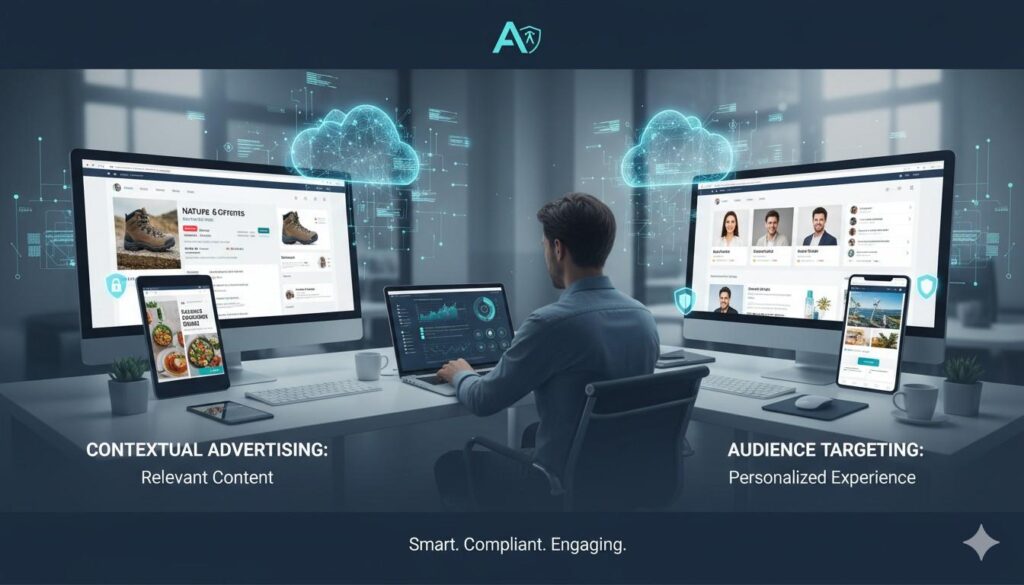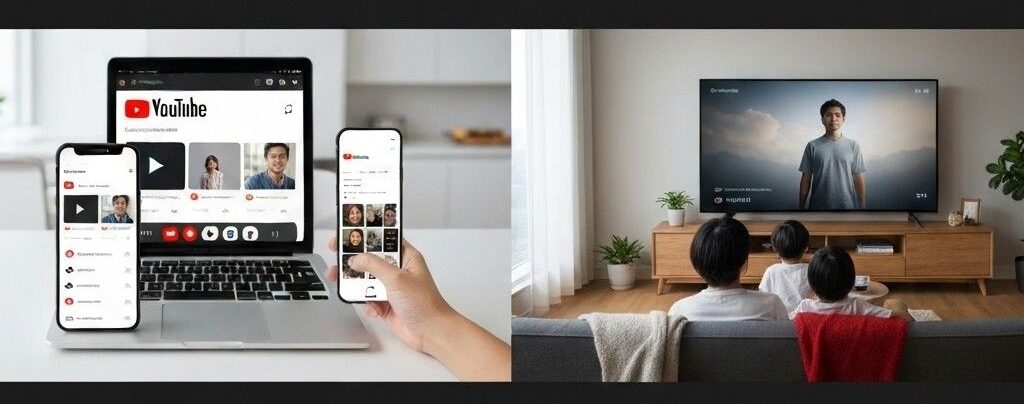Something weird is happening in living rooms.
People aren’t flipping channels anymore, and they’re not watching cable. Half of them can’t even find the remote that controls “regular TV.” They’re watching YouTube on the biggest screen in the house.
No one really talks about how fast this shift happened. One minute, we were optimizing six-second bumper ads for mobile scroll zombies. The next minute? Households are binge-watching creator-led finance shows on a 65-inch screen while folding laundry.
This isn’t some trend report fluff. The rise of YouTube’s viewership on CTV devices is real. And if you’re a media buyer or brand strategist and still planning like it’s 2020, you’re not just behind; you’re invisible.
The Shift to YouTube CTV: Why It Matters
In 2018, mobile devices dominated YouTube viewership, with users watching quick tutorials or unboxings on the go. CTV was a niche player, mostly for streaming Netflix. Fast forward to 2025, and YouTube on CTV accounts for 12% of total viewing time, rivaling traditional TV. Here’s why this shift is critical for brands:
- Pandemic Pivot: Lockdowns rekindled love for big screens, with smart TVs becoming more user-friendly.
- Creator Content: Creator-led shows, like finance deep-dives or hour-long vlogs, outshine Hollywood productions in authenticity.
- Lean-Back Viewing: Families watch together, engaging with long-form content (20–60 minutes) in a distraction-free environment.
This isn’t mobile scrolling. It’s immersive, sound-on, full-screen viewing—perfect for ads that demand attention and engagement.
What YouTube CTV Viewership Looks Like
CTV viewers aren’t snacking on content; they’re invested. Key behaviors include:
- Long-Form Engagement: Viewers binge 25-minute vlogs, explainers, or creator-hosted shows.
- Shared Viewing: Ads play to multiple viewers in living rooms, amplifying brand recall.
- High Attention: Unlike mobile, CTV viewers are focused, not distracted by notifications.

This environment offers brands a golden opportunity to deliver immersive ads that feel like part of the content, not interruptions.
The rise of YouTube’s viewership on CTV devices is changing how people experience ads. Your brand isn’t squeezed between swipeable videos. It’s filling a TV screen with stereo sound in a quiet room, with viewers who are actually paying attention.
That kind of attention? That’s gold. And you don’t need first-party data to get there.

Let’s Talk Context, Not Cookies
Here’s where it gets juicy.
Everyone’s screaming about data deprecation. No cookies. No third-party IDs. No “personalization.” Panic at the programmatic disco.
But guess what? You don’t need to know who someone is to know what they care about.
Contextual targeting lets you reach people based on what they’re watching, not who they are. You don’t need to know age, gender, zip code, or that they bought a blender last week. You just need to show up next to the right content.
Watching a 30-minute video on retirement planning? You’re probably not 17.
Following a creator who does in-depth gear reviews on mountain bikes? That tells me more than a pixel ever could.
Context isn’t a fallback. It’s not the “safe” alternative. It’s smarter. It’s precise. And shocker, it works.
The Real Ad Advantage on YouTube CTV
Let’s call it what it is: YouTube on CTV is the perfect storm.
You get massive reach. You get full-screen immersion. You get detailed performance metrics like view-through rates and skip behavior. And you get it without fighting algorithms or violating privacy laws.
Plus, CPMs are still ridiculously efficient compared to linear and programmatic CTV. You’re not paying through the nose for dead eyeballs. You’re paying for impressions that actually impress.
And if you’re using contextual targeting the right way, meaning community-first, content-verified, and human-reviewed, as outlined in this guide on implementing contextual targeting in CTV campaigns, you’re not just spraying ads across a content wasteland. You’re placing them in curated moments that matter.
People aren’t just watching your ad. They’re feeling it.
Tips That Actually Help
Tired of hearing the same “CTV best practices” that feel like they were copied and pasted from a media deck? Here’s the stuff that works:
- Format matters. You’re on TV now. Stop running mobile-optimized vertical clips. Go widescreen. Use rich sound. Don’t assume people are watching on mute.
- Target communities, not demos. Demos lie. Communities don’t. Nail the culture of gaming dads, finance junkies, and DIY moms, and your ad will blend like it belongs.
- Cap the frequency. Just because you can serve 15 impressions per user doesn’t mean you should. Respect the viewer.
- Skip mobile when you want a TV scale. Exclude phones when running big-screen campaigns. Clean up your results.
- Choose smart bidding models. CPV if you want engagement. CPM if you want reach. Test both. Don’t guess.
Future? It’s Already Here
This isn’t a prediction anymore. It’s reality. isn’t slowing down. And creators? They know i
CTV is where the next decade of video marketing will live. They’re filming longer. Shooting for 4K. Designing intros and hooks like it’s Netflix.
Do you think you have time to wait and “see how this pans out?” You don’t.
Brands that lean into this shift now and embrace contextual, community-led targeting on YouTube CTV are going to clean up. Everyone else will be playing catch-up, wondering why their numbers are flatlining.
Look, Let’s Not Overcomplicate This
YouTube owns CTV right now with 12% of total viewing time. It’s dominating screens, time, attention, and relevance.
The opportunity? It’s not just about more screens. It’s about smarter placements. Safer inventory. Ads that feel like part of the story, not an interruption.
Contextual targeting gives you a way in without data, without identity graphs, and without betting the farm on privacy workarounds. It’s clean. It’s fast. And when done right, it converts.
So, maybe stop chasing the user. Start following the moment.
Ready to Transform Your YouTube Strategy?
Get expert insights and proven strategies delivered to your inbox weekly
Ready to level up your YouTube CTV campaigns with smarter targeting and better safety?
You don’t need to chase users across devices or dig through identity graphs to reach the right audience. Context does the heavy lifting. And if you want that targeting to be real rooted in communities, driven by content, verified by humans Filament is the partner that gets you there.
We’ve built a platform that understands where attention lives and how to place ads in front of it without ever touching personal data. It’s precision without compromise. Contextual without guesswork. And in a world shifting fast toward CTV, it’s exactly the kind of strategy that wins.
FAQ
-
How has YouTube’s viewership on CTV changed compared to mobile and desktop over the last 5 years?
In 2018, mobile dominated. Now, YouTube’s CTV traffic has skyrocketed. In some markets, TV screens are the primary device for long-form content. People are watching creator shows like they used to watch network TV.
In 2025, YouTube accounts for 12% of total CTV viewing time. If you’re not buying YouTube CTV, you’re missing the biggest video platform
-
What makes YouTube’s CTV audience more valuable to advertisers?
You’re not just getting a person; you’re getting the room. Sound on, eyes forward, fewer distractions. Viewers stick longer, engage deeper, and often watch in groups.
-
How can I ensure brand safety when advertising on YouTube via CTV?
Contextual targeting, especially with human-curated channels and communities, is your best friend. Avoid automated broad matches; go specific and verified, and avoid the kids’ content trap.
-
What are some cost-effective ways to optimize YouTube campaigns specifically for TV screens?
Exclude mobile, cap your frequency, and use longer-form, story-based creative. Also, test contextual audiences instead of overpaying for age/gender segments.
-
Is it possible to track conversions from CTV campaigns in the same way as desktop/mobile ads?
It’s different but possible. Use view-through attribution, cross-device tracking, and post-impression surveys. No clicks don’t mean no impact.

I’m a results-driven marketing leader with 10+ years of experience building integrated media strategies that drive measurable ROI. As COO and co-founder of Filament, I shape the product roadmap, sales, and campaign performance. My background spans brand and performance media for top brands like Slack, Bumble, and Jenny Craig. A frequent speaker on measurement, I bring deep expertise in ad tech, data strategy, and media buying—always with a sharp focus on business impact. Previously I founded an attribution company, where I led campaign planning, attribution modeling, and executive-level reporting across TV, digital, and CRM channels.



